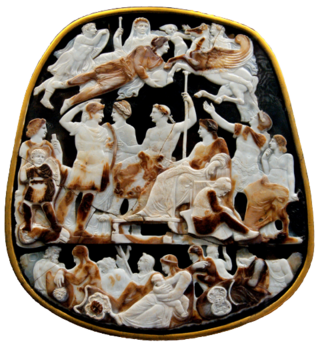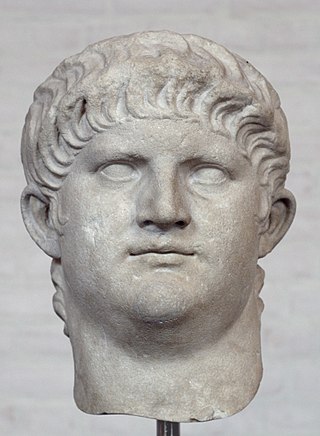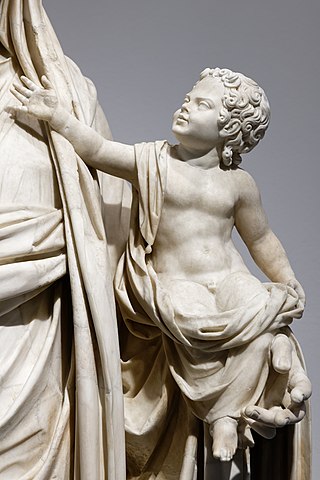Related Research Articles

Julia Agrippina, also referred to as Agrippina the Younger, was Roman empress from AD 49 to 54, the fourth wife and niece of emperor Claudius, and the mother of Nero.

The Julio-Claudian dynasty comprised the first five Roman emperors: Augustus, Tiberius, Caligula, Claudius, and Nero.

Nero Claudius Caesar Augustus Germanicus was a Roman emperor and the final emperor of the Julio-Claudian dynasty, reigning from AD 54 until his death in AD 68.

The 50s decade ran from January 1, 50, to December 31, 59. It was the sixth decade in the Anno Domini/Common Era, if the nine-year period from 1 AD to 9 AD is considered as a "decade".

The 60s decade ran from January 1, AD 60, to December 31, AD 69.
AD 51 (LI) was a common year starting on Friday of the Julian calendar. At the time, it was known as the Year of the Consulship of Caesar and Scipio. The denomination AD 51 for this year has been used since the early medieval period, when the Anno Domini calendar era became the prevalent method in Europe for naming years.

Tiberius Claudius Caesar Britannicus, usually called Britannicus, was the son of Roman Emperor Claudius and his third wife, Valeria Messalina. For a time, he was considered his father's heir, but that changed after his mother's downfall in 48, when it was revealed she had engaged in a bigamous marriage without Claudius' knowledge. The next year, his father married Agrippina the Younger, Claudius' fourth and final marriage. Their marriage was followed by the adoption of Agrippina's son, Lucius Domitius Ahenobarbus, whose name became Nero as a result. His stepbrother would later be married to Britannicus' sister Octavia and soon eclipsed him as Claudius' heir. After his father's death in October 54, Nero became emperor. The sudden death of Britannicus shortly before his fourteenth birthday is reported by all extant sources as being the result of poisoning on Nero's orders; as Claudius' biological son, he represented a threat to Nero's claim to the throne.

Lucius Annaeus Seneca the Younger, usually known mononymously as Seneca, was a Stoic philosopher of Ancient Rome, a statesman, dramatist, and in one work, satirist, from the post-Augustan age of Latin literature.
Ofonius Tigellinus was a prefect of the Roman imperial bodyguard, known as the Praetorian Guard, from 62 until 68, during the reign of emperor Nero. Tigellinus gained imperial favour through his acquaintance with Nero's mother Agrippina the Younger, and was appointed prefect upon the death of his predecessor Sextus Afranius Burrus, a position Tigellinus held first with Faenius Rufus and then Nymphidius Sabinus.

Lucius Aelius Sejanus, commonly known as Sejanus, was a Roman soldier and confidant of the Roman Emperor Tiberius. Of the Equites class by birth, Sejanus rose to power as prefect of the Praetorian Guard, the imperial bodyguard, of which he was commander from AD 14 until his execution for treason in AD 31.
Claudia Acte was a freedwoman of ancient Rome who became a mistress of the emperor Nero. She came from Asia Minor and might have become a slave of the Emperor Claudius, following his expansion of the Roman Empire into Lycia and Pamphylia; or she might have been purchased later, by Octavia, Claudius' daughter.

Drusus Caesar was the grandson by adoption and heir of the Roman emperor Tiberius, alongside his brother Nero. Born into the prominent Julio-Claudian dynasty, Drusus was the son of Tiberius' general and heir, Germanicus.

Nero Julius Caesar was the adopted grandson and heir of the Roman emperor Tiberius, alongside his brother Drusus. Born into the prominent Julio-Claudian dynasty, Nero was the son of Tiberius' general and heir, Germanicus. After the deaths of his father and of Tiberius' son, Drusus the Younger, Nero and his brother Drusus were adopted together by Tiberius in September AD 23. As a result of being heirs of the emperor, he and his brother enjoyed accelerated political careers.

Claudia Octavia was a Roman empress. She was the daughter of the Emperor Claudius and Valeria Messalina. After her mother's death and father's remarriage to her cousin Agrippina the Younger, she became the stepsister of the future Emperor Nero. She also became his wife, in a marriage between the two which was arranged by Agrippina.
Lucius Faenius Rufus, an eques Romanus, was praefectus annonae from AD 55 to 62. Tacitus reports that he did not profit from it. With Tigellinus, he succeeded Sextus Afranius Burrus as praetorian prefect in AD 62. Rufus had a close association with Agrippina the Younger. In 65, however, he was executed for his part as a member of the Pisonian conspiracy against the Emperor Nero.
Lucius Lusius Geta was a Roman politician in the 1st century AD.
Publius Marius P. f. was a Roman senator and ordinary consul in 62 AD with Lucius Afinius Gallus as his colleague. Although Frontinus records that Marius was appointed curator aquarum in 64, we know nothing more about him.
The gens Rufia, occasionally spelled Ruffia, was a minor plebeian family at ancient Rome. Members of this gens are not mentioned in history until imperial times, and they achieved little prominence until the late third century, from which time the family rose in importance, gaining the consulship on a number of occasions from the time of Constantine the Great to that of Justinian, and frequently holding the post of praefectus urbi.
The gens Rufria was a minor plebeian family at ancient Rome. Members of this gens are first mentioned in imperial times. Few of the Rufrii appear in history, but others are known from inscriptions.
Gaius Caecina Tuscus was a 1st-century Roman politician and Prefect of Egypt during the reign of Nero, and is mentioned by Tacitus. Tuscus was a member of the Caecinae, an Etruscan family of Volaterrae, one of the ancient cities of Etruria.
References
- ↑ CIL XII, 5842 = ILS 1321. English translation Robert K. Sherk (1988). The Roman Empire: Augustus to Hadrian. Cambridge University Press. p. 99. ISBN 978-0-521-33887-5.
- ↑ Albino Garzetti (1974). From Tiberius to the Antonines: A History of the Roman Empire AD 14-192. Routledge. pp. 611f. ISBN 978-1-317-69844-9.
- ↑ Anthony A. Barrett (1996). Agrippina: Sex, Power, and Politics in the Early Empire. Yale University Press. pp. 122f. ISBN 978-0-300-07856-5.
- ↑ Boris Rankov (1994). The Praetorian Guard. Osprey Publishing. p. 11. ISBN 978-1-85532-361-2. Archived from the original on 14 February 2016.
- ↑ Tom Holland. Dynasty. p. 400.